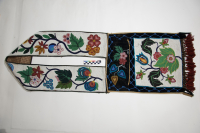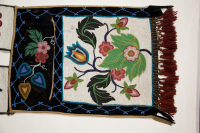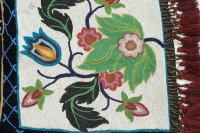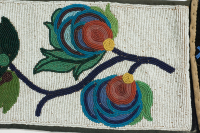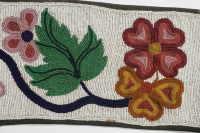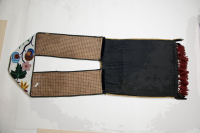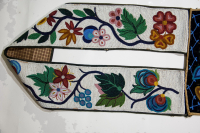Bandolier bag
Bandolier bag
Bandolier bag
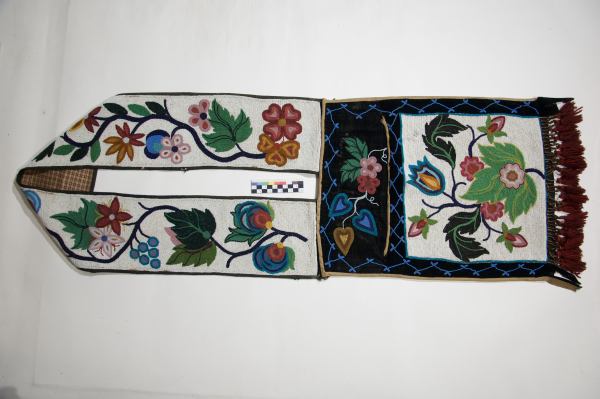
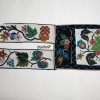
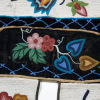
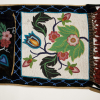
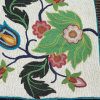
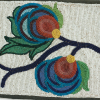
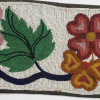
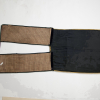
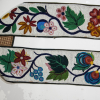
Floral stem & leaf seed bead design on white field strap & pocket, pocket panel on black velveteen, tan bias tape edging, looped tube beads with yarn tassels
Attributed to Saulteaux cultural type.
Summary of Description
Read More About This Relative
fabric, velveteen, black; fabric, cotton, black; fabric, cotton, brown checked; yarn, wine red; thread, beige; binding tape, brown and grey?; tube beads, glass, brown; seed beads, glass, white, black, red, orange, yellow, green, blue;
Hand sewn, Overlaid spot stitch appliqué beadwork; Pouch panel and pocket made of black cotton, edged with brown bias tape which forms tabs at bottom corners;
Pouch panel and pouch on black velveteen bordered with one row applied blue beads in zigzag decoration with extra row beads where angles meet, Pouch sewn shut, decorated with closed backed applied curvilinear multi-coloured floral stem and leaf beaded design in white field, bordered with two rows blue seed beads, Decorative panel above pouch area decorated with floral stem and leaf seed bead design on black velveteen, Straps edged with green bias tape, lined with brown checked cotton, and decorated spot stitch appliqué beadwork design in white field, Strap decoration asymmetrical, Design elements: colours - opaque, semi-translucent, transparent clear seed beads, flowers and leaves exhibit different shades of same colour, or different colours used in one flower etc., Patterns: floral stem and leaf - e.g. rose, tulip, oak leaf ?, heart shaped leaf; Numerous wrong coloured beads placed at random, Fringe is forty-four strands of brown faceted tube beads tied in pairs with red yarn;
Bandolier bags most likely originated in the Upper Great Lakes region during the 1840s and 1850s. Fashioned exclusively from European materials and adorned with thousands of beads, bandolier bags were primarily for show, as a symbol of identity, wealth and status. Although initially functional, by the late 19th and early 20th centuries many of the bags had false pockets or none at all. Sometimes called "friendship bags", they were often created as gifts to strengthen relationships within communities or between nations. By the 1870s they had become an important element of formal dress worn mainly at ceremonies and celebrations by men, and occasionally by women. They wore them - singly or several at a time - crossed over the torso or draped around the neck. “The wearing of more than one bag was generally the prerogative of a leader or a person of high honour." (McCord, 2013) “Bandoliers were adopted by Ojibwa in 19th century after seeing bullet pouches used by British soldiers. Bullet pouches were plain and decorated with crest or coat of arms. When idea adopted by Ojibwa, they were greatly prized and highly decorated ceremonial accessories. They became so highly prized by Ojibwa and other tribes (especially Sioux), that one bandolier could be traded for one pony. They became a status symbol of highest ranking Midewiwin priests. (Flanders, 1977)
Provenance
McCord Museum, Wearing Our Identity. Montreal: The McCord Museum, 2013; and “Beads: Their Use By Upper Great Lakes Indians” by Richard Flanders, 1977
Currently on long term exhibition in the Manitoba Museum's Parklands/Mixed Woods Gallery, "Treaties: We Are All Treaty People".
McCord Museum. Wearing Our Identity. Montreal: The McCord Museum, 2013. Print.
About This GRASAC Record
Manitoba Museum
Content from the Manitoba Museum's catalog records. Originally uploaded by Orvis Starkweather as part of their summer internship.
Addition artifact data uploaded by Tim Worth.













Attributed to Northeast Great Lakes-Riverine Geo-cultural area.
 Knowledge Sharing Platform
Knowledge Sharing Platform

